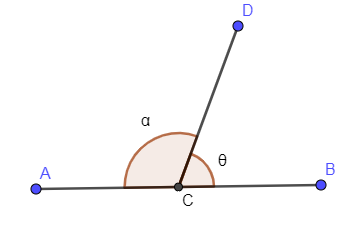
What is the supplementary angle of ${{40}^{\circ }}$?
Answer
492.9k+ views
Hint: We know that supplementary of any angle is the subtraction of that angle from ${{180}^{\circ }}$. So, in this problem we have given an angle of ${{40}^{\circ }}$so its supplementary angle is calculated by subtracting ${{40}^{\circ }}$from ${{180}^{\circ }}$. The result of this subtraction is the supplementary angle that we are looking for.
Complete step by step answer:
In the above problem, we are asked to find the supplementary angle of ${{40}^{\circ }}$.
The supplementary angle of any angle is equal to the subtraction of that angle from ${{180}^{\circ }}$.
Let us assume angle $\theta $ is the angle with respect to which we have to find the supplementary angle and the supplementary angle be $\alpha $.
In the below diagram, we have shown a straight line along with the angle $\theta $ and angle $\alpha $.

As you can see that $\theta \And \alpha $ are forming the linear pairs so the summation of both these angles is equal to ${{180}^{\circ }}$.
Adding $\theta \And \alpha $ and equating it to ${{180}^{\circ }}$ we get,
$\begin{align}
& \theta +\alpha ={{180}^{\circ }} \\
& \Rightarrow \alpha ={{180}^{\circ }}-\theta ......Eq.(1) \\
\end{align}$
Now, we have assumed that $\alpha $ is the supplementary angle of $\theta $.
In the above question, we are asked to find the supplementary angle of ${{40}^{\circ }}$ so from the above description of supplementary angle, $\theta ={{40}^{\circ }}$ so substituting this value of $\theta $ in eq. (1) we will get the value of supplementary angle corresponding to ${{40}^{\circ }}$.
$\begin{align}
& \alpha ={{180}^{\circ }}-\theta \\
& \Rightarrow \alpha ={{180}^{\circ }}-{{40}^{\circ }} \\
& \Rightarrow \alpha ={{140}^{\circ }} \\
\end{align}$
Hence, we have found the supplementary angle of ${{40}^{\circ }}$ as ${{140}^{\circ }}$.
Note: You can cross check the value of supplementary angle of ${{40}^{\circ }}$ that we have calculated above by using the relation that sum of the angle and its supplement is ${{180}^{\circ }}$.
The angle is ${{40}^{\circ }}$ and its supplementary that we have calculated above is ${{140}^{\circ }}$. Now, the addition of these two angles must be equal to ${{180}^{\circ }}$.
${{40}^{\circ }}+{{140}^{\circ }}={{180}^{\circ }}$
Adding the left hand side of the above equation we get,
${{180}^{\circ }}={{180}^{\circ }}$
As you can see that L.H.S = R.H.S so the supplementary angle that we have calculated above is correct.
Complete step by step answer:
In the above problem, we are asked to find the supplementary angle of ${{40}^{\circ }}$.
The supplementary angle of any angle is equal to the subtraction of that angle from ${{180}^{\circ }}$.
Let us assume angle $\theta $ is the angle with respect to which we have to find the supplementary angle and the supplementary angle be $\alpha $.
In the below diagram, we have shown a straight line along with the angle $\theta $ and angle $\alpha $.

As you can see that $\theta \And \alpha $ are forming the linear pairs so the summation of both these angles is equal to ${{180}^{\circ }}$.
Adding $\theta \And \alpha $ and equating it to ${{180}^{\circ }}$ we get,
$\begin{align}
& \theta +\alpha ={{180}^{\circ }} \\
& \Rightarrow \alpha ={{180}^{\circ }}-\theta ......Eq.(1) \\
\end{align}$
Now, we have assumed that $\alpha $ is the supplementary angle of $\theta $.
In the above question, we are asked to find the supplementary angle of ${{40}^{\circ }}$ so from the above description of supplementary angle, $\theta ={{40}^{\circ }}$ so substituting this value of $\theta $ in eq. (1) we will get the value of supplementary angle corresponding to ${{40}^{\circ }}$.
$\begin{align}
& \alpha ={{180}^{\circ }}-\theta \\
& \Rightarrow \alpha ={{180}^{\circ }}-{{40}^{\circ }} \\
& \Rightarrow \alpha ={{140}^{\circ }} \\
\end{align}$
Hence, we have found the supplementary angle of ${{40}^{\circ }}$ as ${{140}^{\circ }}$.
Note: You can cross check the value of supplementary angle of ${{40}^{\circ }}$ that we have calculated above by using the relation that sum of the angle and its supplement is ${{180}^{\circ }}$.
The angle is ${{40}^{\circ }}$ and its supplementary that we have calculated above is ${{140}^{\circ }}$. Now, the addition of these two angles must be equal to ${{180}^{\circ }}$.
${{40}^{\circ }}+{{140}^{\circ }}={{180}^{\circ }}$
Adding the left hand side of the above equation we get,
${{180}^{\circ }}={{180}^{\circ }}$
As you can see that L.H.S = R.H.S so the supplementary angle that we have calculated above is correct.
Recently Updated Pages
The correct geometry and hybridization for XeF4 are class 11 chemistry CBSE

Water softening by Clarks process uses ACalcium bicarbonate class 11 chemistry CBSE

With reference to graphite and diamond which of the class 11 chemistry CBSE

A certain household has consumed 250 units of energy class 11 physics CBSE

The lightest metal known is A beryllium B lithium C class 11 chemistry CBSE

What is the formula mass of the iodine molecule class 11 chemistry CBSE

Trending doubts
Fill the blanks with the suitable prepositions 1 The class 9 english CBSE

Given that HCF 306 657 9 find the LCM 306 657 class 9 maths CBSE

Difference Between Plant Cell and Animal Cell

Draw an outline map of India and mark the following class 9 social science CBSE

Differentiate between the Western and the Eastern class 9 social science CBSE

What is pollution? How many types of pollution? Define it




